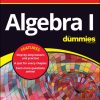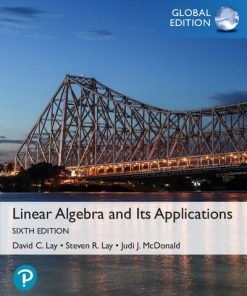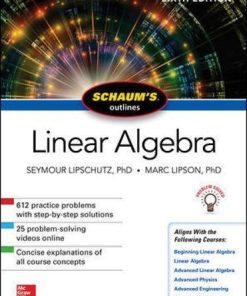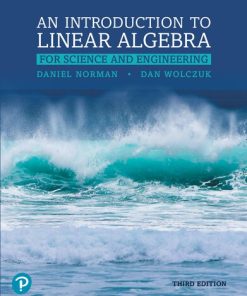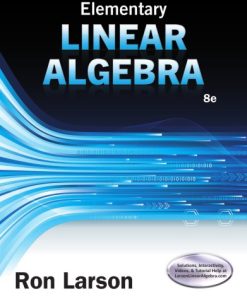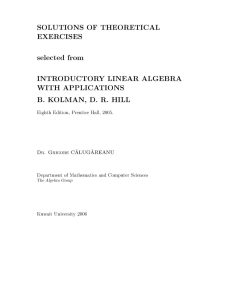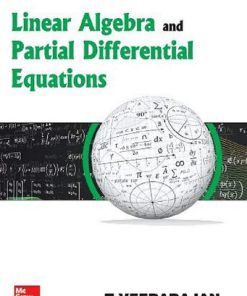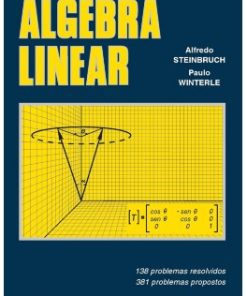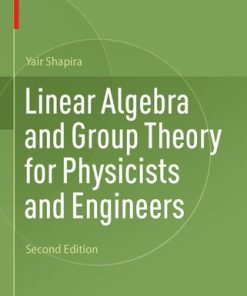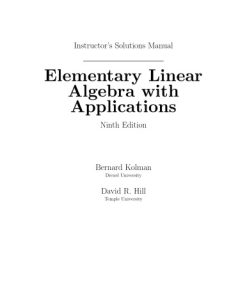(EBook PDF) The Oxford Linear Algebra for Scientists 1st edition by Andre Lukas 0192583476 9780192583475 full chapters
$50.00 Original price was: $50.00.$25.00Current price is: $25.00.
The Oxford Linear Algebra for Scientists 1st edition by Andre Lukas – Ebook PDF Instant Download/DeliveryISBN: 0192583476, 9780192583475
Full download The Oxford Linear Algebra for Scientists 1st edition after payment

Product details:
ISBN-10 : 0192583476
ISBN-13 : 9780192583475
Author: Andre Lukas
This textbook provides a modern introduction to linear algebra, a mathematical discipline every first year undergraduate student in physics and engineering must learn. A rigorous introduction into the mathematics is combined with many examples, solved problems, and exercises as well as scientific applications of linear algebra. These include applications to contemporary topics such as internet search, artificial intelligence, neural networks, and quantum computing, as well as a number of more advanced topics, such as Jordan normal form, singular value decomposition, and tensors, which will make it a useful reference for a more experienced practitioner. Structured into 27 chapters, it is designed as a basis for a lecture course and combines a rigorous mathematical development of the subject with a range of concisely presented scientific applications. The main text contains many examples and solved problems to help the reader develop a working knowledge of the subject and every chapter comes with exercises.
The Oxford Linear Algebra for Scientists 1st Table of contents:
Part I Preliminaries
Sets and functions
Sets
(Non-) definition of sets
Set operations
New sets from old ones
Relations
Basic definitions
Properties of equivalence relations
Functions
Definition of functions
Composition of functions
Properties of functions
The inverse function
Rudiments of logic
Predicates and Boolean operations
Implications
Quantifiers
Patterns of proofs
Exercises
Groups
Definition and basic properties
Definition
Examples of groups
Sub-groups
Group homomorphisms
Permutation groups
Calculating with permutations
Permutations in terms of transpositions
The sign of permutations
Exercises
Fields
Fields and their properties
Definition
Some conclusions from the field axioms
Order on fields
Examples of fields
The complex numbers
Construction of complex numbers
Complex conjugation
Beyond R2
Basics of polynomials
Basics and polynomial division
Zeros and multiplicity
Factorization
Exercises
Part II Vector spaces
Coordinate vectors
Basic definitions
Definition of coordinate vectors
Addition and scalar multiplication
Calculating with coordinate vectors
Standard unit vectors
Definition of standard unit vectors
Calculating with standard unit vectors
Exercises
Vector spaces
Basic definitions
Vector space axioms
Implications of vector space axioms
Vector subspaces
Linear Maps
Algebras
Examples of vector spaces
Coordinate vector spaces
Matrices and matrix vector spaces
Vector spaces of functions
Exercises
Elementary vector space properties
Linear independence
Linear combinations and span
Linear independence
Properties of linearly independent vectors
Examples for linear independence
Basis and dimension
Basis and coordinates
Examples of bases and coordinates
Dimension of a vector space
Existence of a basis
Properties of finite-dimensional vector spaces
Exercises
Vector subspaces
Intersection and sum
Intersection of vector subspaces
Union and sum
Dimension of vector space sums
Direct sums
Direct sums of vector spaces
Quotient spaces*
Equivalence relation and cosets
Quotient vector space
Exercises
Part III Basic geometry
The dot product
Basic properties
Definition of dot product
Properties of the dot product
Length and angle
Definition of length
The Cauchy–Schwarz inequality
Properties of the length
The angle between vectors
Orthogonality
Definition of orthogonality
The Kronecker delta symbol
Orthonormal basis
Exercises
Vector and triple product
The cross product
Orthogonality in two dimensions
Definition of cross product in R3
Existence and uniqueness of the cross product
The Levi-Civita symbol in R3
Properties of the cross product
Geometrical interpretation of the cross product
The triple product
Definition of triple product
Calculation of the determinant
Interpretation of the triple product
Exercises
Lines and planes
Lines in R2
Parametric and Cartesian form
Intersection of two lines
Lines and planes in R3
Parametric and Cartesian form for planes
Parametric and Cartesian form for lines
Minimal distances
Intersection of two planes
Intersection of line and plane
Intersection of three planes
Exercises
Part IV Linear maps and matrices
Introduction to linear maps
First properties of linear maps
Reminder of definition
Existence and construction of linear maps
Addition and scalar multiplication of linear maps
Map composition and inverse
Isomorphisms and general linear groups
Examples of linear maps
Coordinate maps
Differential operators
Exercises
Matrices
Matrices as linear maps
Linear maps between coordinate vectors
Matrix-vector multiplication
The two faces of matrices
Square and diagonal matrices
Matrix multiplication
Matrix multiplication from map composition
Rules for matrix multiplication
Matrix inverse and general linear group
Transpose and Hermitian conjugate
The transpose of a matrix
Symmetric and anti-symmetric matrices
Properties of transposition
The Hermitian conjugate of a matrix
Hermitian and anti-Hermitian matrices
Properties of Hermitian conjugation
Exercises
The structure of linear maps
Image and kernel
Definition of image and kernel
Rank of a linear map
Injective and surjective linear maps
The rank theorem
Motivation
The theorem
Easy conclusions from the rank theorem
Isomorphisms
The inverse of a linear map
Another proof of the rank theorem*
Exercises
Linear maps in terms of matrices
Matrices representing linear maps
Basis choice
Computing the representing matrix
Examples for matrices describing linear maps
Change of basis
General case
Identical domain and co-domain
Conjugate matrices
Exercises
Part V Linear systems and algorithms
Computing with matrices
Row operations
Definition of row operations
Upper echelon form
Algorithm to bring a matrix into upper echelon form
Rank of a matrix
Row and column rank
Computing the rank
Matrix inverse
The elementary matrices
Algorithm to calculate the matrix inverse
Exercises
Linear systems
Abstract linear systems
Definition of linear systems
Structure of solution space
Systems of linear equations
Definition
Solutions of homogeneous system
Solution of inhomogeneous system
Examples with explicit calculation
Row operations for linear equations
Algorithm for solving linear equations
Applications to geometry
Parametric and Cartesian form
Intersection of affine k-planes
Intersections and linear systems
Exercises
Determinants
Existence and uniqueness
Definition of determinant
The general formula for the determinant
The Levi-Civita symbol
The determinant in low dimensions
Determinants for triangular matrices
Properties of the determinant
Determinant and transposition
Determinant and matrix multiplication
Determinant and basis transformation
Orientation
Computing with determinants
The co-factor matrix
Laplace expansion of determinant
Matrix inverse from co-factors
Determinant and row operations
Minors
Cramer’s rule
Exercises
Part VI Eigenvalues and eigenvectors
Basics of eigenvalues
Eigenvalues and eigenspaces
Definition of eigenvalues and eigenvectors
Degeneracy and eigenspaces
The characteristic polynomial
Definition of characteristic polynomial
Properties of the characteristic polynomial
Examples
Degeneracy and multiplicity
Class functions
The theorem of Cayley–Hamilton*
Polyomials of endomorphisms
The minimal polynomial
The theorem
Exercises
Diagonalizing linear maps
Diagonalization
Basic criteria
The diagonal matrix
Diagonalizing and class functions
Examples
Projectors
Definition of projectors
Diagonalizing projectors
Simultaneous diagonalization*
Diagonalization of restricted maps
Criterion for simultaneous diagonalization
Exercises
The Jordan normal form*
Nilpotent endormorphisms*
Powers of endomorphisms
Definition of nilpotentency
Structure of nilpotent endomorphisms
Examples
The Jordan form*
The decomposition theorem
The theorem
Implications of Jordan normal form
Examples*
Exercises
Part VII Inner product vector spaces
Scalar products
Real and Hermitian scalar products
Definition of norms
Definition of scalar products
The norm associated to a scalar product
Orthogonal vectors and angles
Examples of scalar products
Orthogonality and Gram–Schmidt procedure
Ortho-normal bases
Existence of ortho-normal bases
Construction of ortho-normal bases
Properties of ortho-normal bases
Orthogonal spaces
Exercises
Adjoint and unitary maps
Adjoint and self-adjoint maps
Definition and basic properties of adjoint map
Adjoint map relative to a basis
Examples
Kernel and image of the adjoint map
Self-adjoint maps
Unitary maps
Definition of unitary maps
Unitary groups
Orthogonal matrices
Unitary matrices
Exercises
Diagonalization — again
Hermitian maps
Eigenvectors and eigenvalues of Hermitian maps
Diagonalizing Hermitian maps
Examples
Normal maps*
Definition of normal maps
Diagonalization of normal maps
Diagonalizing unitary maps
Orthogonal matrices
Three-dimensional rotations — again
Singular value decomposition*
General bases
Ortho-normal bases
Functions of matrices*
Defining functions of matrices
Matrix functions and diagonalization
Direct computation of matrix functions
Exercises
Bi-linear and sesqui-linear forms*
Basics definitions*
Definition of bi-linear and sesqui-linear forms
The associated quadratic form
Linear forms relative to a basis
Positive definiteness
Degeneracy
Classification of linear forms*
A normal form for the describing matrix
Theorem of Sylvester
Groups associated to linear forms
Quadratic hyper-surfaces*
Definition of quadratic hyper-surfaces
Diagonalization of quadratic hyper-surfaces
Quadratic curves in R2
Quadratic surfaces in R3
Exercises
Part VIII Dual and tensor vector spaces*
The dual vector space*
Definition of dual vector space*
Linear functionals
Dual basis
Index notation
The double dual
The dual map*
The orthogonal space
The dual map
People also search for The Oxford Linear Algebra for Scientists 1st:
linear algebra for scientists
linear algebra for scientists and engineers
c linear algebra
oxford linear algebra
c linear algebra library
Tags:
The Oxford,Linear Algebra,Scientists,Andre Lukas
You may also like…
Mathematics
Mathematics - Algebra
Introduction to Linear Algebra for Science and Engineering 3rd Edition
Mathematics Mathematics - Algebra
Elementary Linear Algebra 8th Edition by Ron Larson 9798214342214
Mathematics - Algebra
Introductory Linear Algebra With Appliacations 1st edition by Kolman, Hill
Mathematics - Differential Equations
Linear Algebra and Partial Differential Equations 1st Edition T Veerarajan
Mathematics - Algebra
Mathematics - Mathematical Physics
Linear Algebra and Group Theory for Physicists and Engineers 2nd Edition Yair Shapira
Mathematics - Algebra
Instructor’s Solutions Manual for Elementary Linear Algebra with Application 9th Edition


